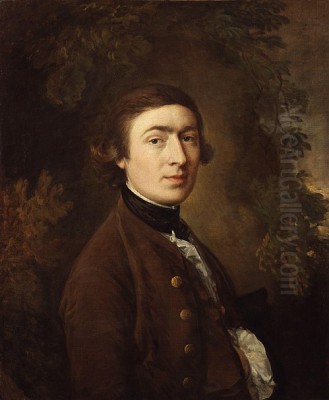
Thomas Gainsborough stands as one of the towering figures of 18th-century British art, a master celebrated equally for his dazzling society portraits and his deeply felt landscape paintings. Flourishing during a vibrant period of cultural and artistic development in Britain, Gainsborough navigated the demands of patronage and the burgeoning art market while forging a style uniquely his own – characterized by a light, fluid touch, a sensitive handling of colour, and an intuitive grasp of character and atmosphere. Alongside his great rival, Sir Joshua Reynolds, he defined the visual identity of Georgian England, yet his approach often diverged, favouring natural intuition over academic theory. His legacy extends far beyond his own time, profoundly influencing the course of British landscape painting and securing his place as an artist of enduring appeal and significance.
Early Life and Artistic Awakening in Suffolk
Thomas Gainsborough was born in Sudbury, Suffolk, in May 1727, and baptised on the 14th of that month. He was the fifth son and youngest of the nine children of John Gainsborough, a weaver and maker of woollen goods, and his wife, Mary Burrough. Sudbury, a town with a history rooted in the wool trade, provided the backdrop for his earliest years. While his father managed the business aspects of the family, his mother was reportedly an amateur painter of flower pieces, suggesting an early exposure to artistic pursuits within the household. His brothers were known more for their inventive, if sometimes eccentric, mechanical inclinations than for art.
From a young age, Thomas displayed a remarkable aptitude for drawing and painting. The Suffolk countryside, with its gentle hills, wooded valleys, and meandering rivers, became his first sketchbook. Anecdotes tell of a precocious boy who sketched the trees and fields around Sudbury with astonishing accuracy and feeling. One famous story recounts how he sketched a man stealing pears from his father's orchard, the likeness so convincing that the thief was identified. By the age of ten, he was already producing accomplished small landscape paintings and portraits.
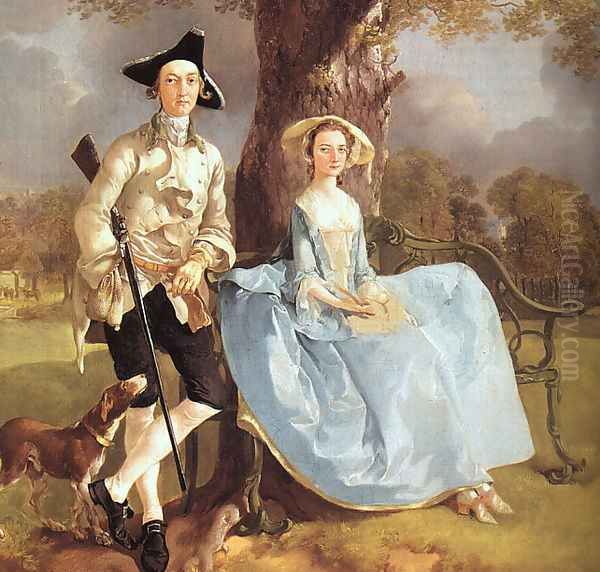
Recognizing his exceptional talent, his family decided to send him to London to pursue formal art training around 1740, when he was just thirteen years old. This move marked a crucial step, immersing the young artist in the dynamic artistic environment of the capital, far removed from the relative quiet of rural Suffolk. London offered opportunities for learning and exposure that were unavailable in his hometown, setting the stage for his professional development.
London Training and Early Influences
In London, the young Gainsborough entered a world brimming with artistic activity and diverse influences. He initially studied under the tutelage of Hubert-François Gravelot, a French engraver and book illustrator whose elegant Rococo style left a discernible mark on Gainsborough's early work, particularly in the delicate handling of figures and compositions. Gravelot's studio was a hub for aspiring artists, and it provided Gainsborough with valuable technical skills and exposure to contemporary French aesthetics.
He is also believed to have associated with William Hogarth and his circle at the St Martin's Lane Academy, a less formal but highly influential gathering place for artists who championed a more native, less rigidly academic approach to art than the continental academies. Hogarth's emphasis on observation, narrative, and contemporary life likely resonated with the young Gainsborough.
Furthermore, Gainsborough worked as an assistant to Francis Hayman, a painter known for his robust portraits, conversation pieces, and decorative history paintings. Hayman was one of the founding members of the future Royal Academy and a prominent figure in the London art scene. Working with Hayman, Gainsborough likely gained experience in various genres and large-scale decorative projects, including contributing to the painted decorations for the popular Vauxhall Gardens.
During this formative period in London, Gainsborough also immersed himself in the study of Old Masters. He developed a particular admiration for 17th-century Dutch landscape painters such as Jacob van Ruisdael, Meindert Hobbema, and Jan Wynants. Their naturalistic depictions of the countryside, attention to atmospheric effects, and detailed rendering of foliage deeply impressed him and laid the foundation for his lifelong passion for landscape painting. He also studied the works of Flemish masters like Anthony van Dyck, whose elegant portraiture would become a key influence later in his career.
Return to Suffolk and Early Career
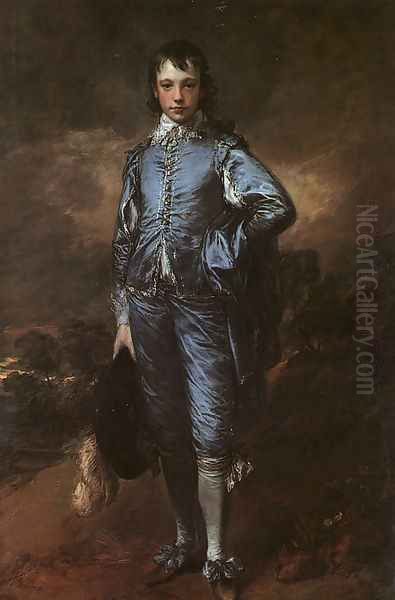
Around 1749, after several years in London, Gainsborough returned to his native Suffolk, initially settling back in Sudbury before moving to the larger town of Ipswich around 1752. His London training had equipped him with considerable skill, but establishing a successful career proved challenging. He married Margaret Burr in 1746, a young woman of disputed parentage but who possessed an annuity of £200, often said to be the illegitimate daughter of the Duke of Beaufort. This independent income provided a crucial measure of financial stability during his early, less certain years. The couple would go on to have two daughters, Mary and Margaret, who frequently featured in his more intimate paintings.
During this period, Gainsborough focused on painting portraits of the local gentry and burgeoning middle class in Suffolk. Commissions were modest compared to the lucrative London market, but they allowed him to hone his skills. He also continued to paint landscapes, his true passion, often exploring the countryside around Ipswich. However, he found that landscapes were difficult to sell; portraiture was the more reliable source of income, a reality that would persist throughout much of his career.
One of the masterpieces from this early Suffolk period is Mr. and Mrs. Andrews (c. 1750). This iconic painting masterfully combines portraiture and landscape, depicting a young landed couple posed somewhat stiffly against an expansive backdrop of their estate. The work is remarkable for its fresh, detailed rendering of the English countryside and its subtle social commentary. It showcases Gainsborough's early ability to integrate figures into believable landscape settings, a hallmark that would distinguish his later work. The painting demonstrates his grounding in the topographical tradition but elevates it with a personal sensitivity to light and atmosphere.
The Bath Period: Rising Fame
Seeking greater opportunities and a wealthier clientele, Gainsborough moved his family to the fashionable spa town of Bath in 1759. This move proved transformative for his career. Bath was a major social hub for the British aristocracy and affluent classes, who flocked there for health treatments and seasonal entertainment. This concentration of potential patrons provided Gainsborough with an ideal environment to establish himself as a leading portrait painter.
In Bath, Gainsborough's reputation soared. His portrait style evolved, becoming increasingly elegant, fluid, and sophisticated, perfectly suited to the tastes of his fashionable sitters. He developed a lighter palette and a more feathery brushstroke, capturing the shimmer of silk, the softness of lace, and the fleeting expressions of his subjects with remarkable facility. He moved away from the tighter handling of his Suffolk years towards a more suggestive and atmospheric approach.
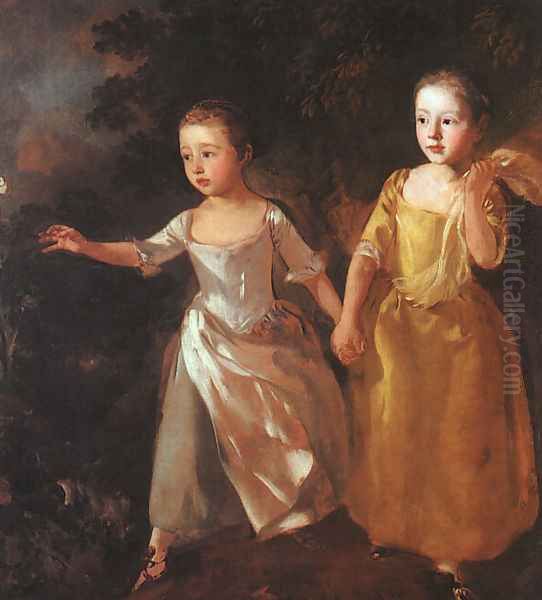
His studio in Bath became highly sought after. He painted numerous members of high society, including aristocrats, politicians, actors, and musicians. Works from this period demonstrate his growing confidence and mastery. He was particularly adept at capturing the grace and poise of his female sitters, often elongating their figures slightly to enhance their elegance. The influence of Anthony van Dyck became increasingly apparent in the sophisticated poses and refined air of his portraits, leading some to see him as Van Dyck's natural successor in England.
While portraiture dominated his commissioned work in Bath, Gainsborough continued to pursue landscape painting for his own pleasure and occasionally for exhibition. He experimented with different landscape styles, sometimes evoking the pastoral calm of Claude Lorrain, other times the more rustic charm of Dutch masters. He also began developing his 'Fancy Pictures' – imaginative compositions featuring idealized rural figures, often children, in landscape settings – which allowed him greater creative freedom than commissioned portraits. His time in Bath solidified his national reputation and set the stage for his eventual move to the ultimate artistic center: London.
London, the Royal Academy, and Royal Patronage
In 1774, at the height of his success in Bath, Gainsborough made the decisive move to London, renting a substantial part of Schomberg House in Pall Mall. London was the undisputed center of the British art world, and establishing a presence there was essential for reaching the pinnacle of his profession. By this time, the Royal Academy of Arts had been founded (in 1768), with Gainsborough as one of its original 36 Foundation Members, alongside his great rival, Sir Joshua Reynolds, who served as its first President.
Gainsborough regularly exhibited his works at the Royal Academy's annual exhibitions, showcasing both portraits and landscapes. These exhibitions were major social and cultural events, and success there could significantly enhance an artist's reputation and attract commissions. His London portraits continued in the elegant vein developed in Bath, characterized by their silvery tones, fluid brushwork, and insightful characterization. He painted many of the leading figures of the day, cementing his status as one of the country's foremost portraitists.
His relationship with the Royal Academy, however, was not always smooth. Gainsborough was known for his independent spirit and sometimes chafed under institutional constraints. He famously clashed with the Academy's hanging committee in 1784 over the placement of his painting The Marsham Children, insisting it be hung lower than the committee dictated to be seen to best effect. When his request was denied, he withdrew the painting and ceased exhibiting at the Academy altogether, choosing instead to show works periodically at his studio in Schomberg House.
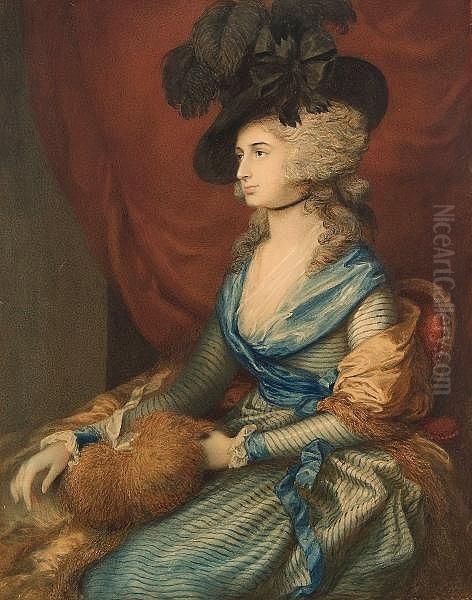
Despite this break with the Academy, Gainsborough's prestige remained high. He enjoyed the patronage of the Royal Family, frequently painting King George III, Queen Charlotte, and other members of the royal household. While Reynolds held the official title of Principal Painter to the King, the Royal Family seemed to genuinely prefer Gainsborough's less formal, more natural style and amiable personality. His royal portraits are noted for their relative intimacy and lack of stiff formality compared to more traditional state portraiture. The London years represented the apex of his career, marked by widespread acclaim, significant commissions, and continued artistic development.
Gainsborough the Portraitist: Capturing Likeness and Spirit
Portraiture formed the backbone of Gainsborough's professional career, providing his primary source of income and public recognition. While he often expressed a preference for landscape painting, his genius for capturing the likeness and, more importantly, the spirit of his sitters was undeniable. His approach contrasted significantly with that of his main rival, Sir Joshua Reynolds. Reynolds, as President of the Royal Academy, advocated the 'Grand Manner,' often imbuing his portraits with historical or mythological allusions and adhering to academic principles derived from Italian Renaissance and Baroque art.
Gainsborough, on the other hand, relied more on intuition and direct observation. His portraits are celebrated for their freshness, immediacy, and psychological insight. He possessed an uncanny ability to convey the personality of the sitter through subtle nuances of expression, pose, and handling of paint. His brushwork was characteristically light, fluid, and suggestive, often described as feathery or flickering. He applied paint in thin layers, using hatching and scumbling techniques to create effects of light, texture, and movement, particularly evident in the rendering of fabrics like silk and satin.
His palette often favored cool, silvery blues, greens, and greys, contributing to the overall elegance and refinement of his portraits. He frequently placed his sitters in landscape settings, even in full-length formal portraits, integrating figure and ground in a way that felt more natural and less artificial than the staged backdrops often employed by his contemporaries. This reflected his deep love for nature and his belief in its importance as an appropriate setting for representing individuals.
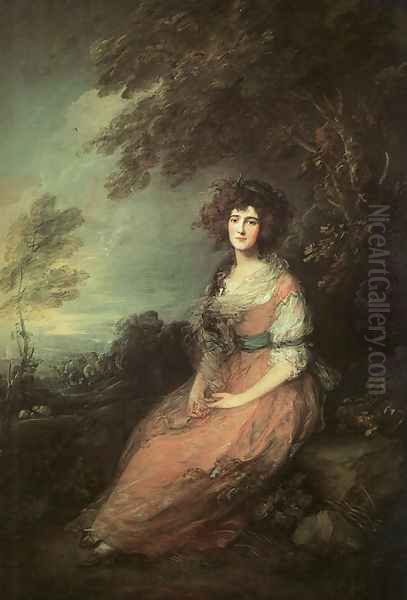
Among his most famous portraits is The Blue Boy (c. 1770), an iconic image depicting a youth in anachronistic 17th-century attire. Often seen as a response to Reynolds's discourses on colour theory (specifically, Reynolds's assertion that blue should be used sparingly in the foreground), the painting is a dazzling technical display and a homage to the portraits of Van Dyck. Other masterpieces include the sensitive double portrait of his daughters, The Painter's Daughters Chasing a Butterfly (c. 1756), the dignified Portrait of Mrs. Siddons (1785), and the elegant Mrs. Richard Brinsley Sheridan (1785-87). He painted many leading figures, including the musician Johann Christian Bach, the actor David Garrick, and numerous members of the aristocracy like the Portrait of Mrs. Graham (1777). His portraits remain compelling not just as records of appearance, but as vivid encounters with the personalities of 18th-century Britain. Other notable portraitists of the era included George Romney, Allan Ramsay, and Francis Cotes, each with their own distinct style, but Gainsborough's unique blend of elegance and naturalism set him apart.
Gainsborough the Landscapist: A Lifelong Passion
Although portraiture paid the bills, Gainsborough consistently declared that landscape painting was his true love. "I'm sick of Portraits and wish very much to take my Viol da Gamba and walk off to some sweet Village where I can paint Landskips and enjoy the fag End of Life in quietness and ease," he famously wrote to his friend William Jackson. Throughout his career, alongside his commissioned portraits, he produced a significant body of landscape work, driven by personal inclination rather than commercial demand.
His early landscapes, influenced by Dutch 17th-century painters like Ruisdael and Hobbema, depicted the recognizable countryside of his native Suffolk with a degree of naturalistic detail. Works like Cornard Wood (1748) show his early mastery of complex compositions and his sensitivity to the textures and light of the English countryside.
As his style evolved, particularly during the Bath and London periods, his landscapes became less topographical and more idealized and poetic. He absorbed the influence of classical landscape painters like Claude Lorrain, known for his harmonious compositions and golden light, and perhaps the idyllic, pastoral scenes of French Rococo painters like Antoine Watteau and Jean-Honoré Fragonard. However, Gainsborough's landscapes retained a distinctly English character, rooted in his observation of nature but transformed by his imagination.
He developed a highly personal landscape style characterized by fluid, rhythmic brushwork, shimmering light effects, and a focus on atmosphere and mood rather than precise detail. He often composed his landscapes in the studio, sometimes using models constructed from stones, twigs, broccoli, and pieces of mirror to create miniature scenes from which to work. This allowed him to experiment freely with composition and lighting effects.
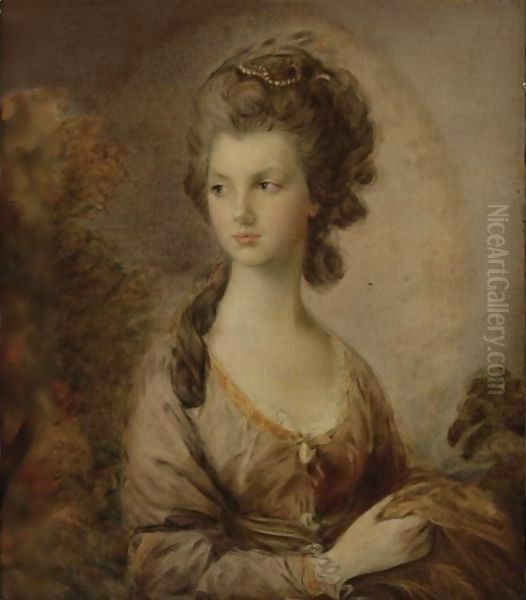
His later landscapes, including works like The Harvest Wagon (c. 1767, reworked 1784-85) and The Market Cart (1786-87), often feature rustic figures and animals integrated into lush, sometimes turbulent, natural settings. These works convey a sense of the vitality and harmony of rural life, though often tinged with a gentle melancholy or nostalgia. He also produced a series of 'Fancy Pictures' in his later years, such as The Cottage Door (c. 1780), which depicted idealized scenes of peasant life with a sentimental charm that appealed to contemporary tastes for sensibility. These works, along with his more purely natural landscapes, were highly innovative and played a crucial role in elevating landscape painting's status in Britain, paving the way for later masters like John Constable and J.M.W. Turner. Richard Wilson was another important contemporary landscape painter, but Gainsborough's approach was generally less classical and more intuitive.
Technique, Innovation, and Materials
Gainsborough's technique was notable for its speed, fluidity, and experimental nature. Contemporaries often remarked on his rapid method of working and the seemingly effortless grace of his brushwork. He famously used long brushes, sometimes up to six feet in length, which allowed him to maintain a distance from the canvas and achieve a broader, more suggestive handling of paint. He applied paint thinly, often in parallel strokes or 'hatchings,' allowing underlying layers or the canvas ground to show through, contributing to the vibrancy and lightness of his surfaces.
His use of colour was intuitive and sensitive. While known for his silvery blues and greens, he could deploy a wide range of hues effectively. He paid close attention to the effects of light, using subtle tonal gradations and sometimes dramatic contrasts to create atmosphere and model form. The 'unfinished' appearance noted by some critics, particularly in comparison to the more polished surfaces of Reynolds, was integral to the sense of immediacy and life in his work.
Gainsborough was also an innovator in his use of materials and techniques beyond traditional oil painting. He was a prolific and accomplished draughtsman, producing numerous sketches in pencil, chalk, and wash, often as studies for paintings but also as independent works of art. These drawings reveal his quickness of observation and his mastery of line and tone.
He experimented with printmaking, producing soft-ground etchings and aquatints that translated the painterly qualities of his drawings into reproducible media. In his later years, he became fascinated with creating transparent paintings on glass, designed to be viewed with backlighting. This 'Eidophusikon'-like device, consisting of a series of painted glass slides in a specially constructed viewing box lit by candles, allowed him to explore dramatic effects of light and shadow in landscape scenes, anticipating later developments in visual entertainment. His willingness to experiment with different media and techniques underscores his restless creativity and his constant search for new ways to capture the effects of light and nature.
Personal Life, Character, and Interests
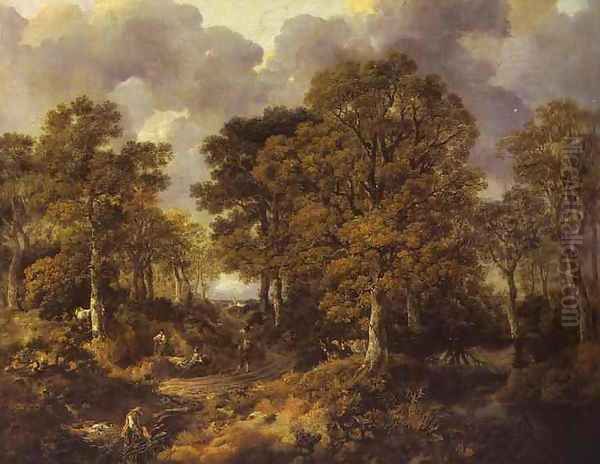
Beyond his artistic achievements, Gainsborough was known as a man of considerable charm, warmth, and sensibility, though also possessing a somewhat volatile and impulsive temperament. He formed close friendships with musicians, actors, and writers, suggesting a sociable nature and broad cultural interests. His love for music was particularly strong; he played the viola da gamba, violin, and harpsichord with enthusiasm, if not always with professional polish. His circle included prominent musicians like Carl Friedrich Abel and Johann Christian Bach (son of J.S. Bach), both of whom he painted memorable portraits.
His marriage to Margaret Burr appears to have been generally stable, providing him with companionship and essential financial security early in his career. They had two daughters, Mary (born 1750) and Margaret (born 1751). Gainsborough painted numerous affectionate portraits of his daughters throughout their lives. Sadly, Mary later suffered from mental illness, a source of great distress to her parents. Margaret, the younger daughter, never married and lived with her mother after Gainsborough's death.
Anecdotes passed down by friends and acquaintances paint a picture of a man who was generous, witty, and passionate about his art, but also prone to moments of irritability and impatience, particularly regarding the business side of his profession and the perceived slights from institutions like the Royal Academy. He often expressed disdain for the demands of portraiture ("the curs'd Face Business") and longed for the freedom to paint landscapes. His letters reveal a lively mind, a playful sense of humor, and a deep sensitivity to the natural world.
The stories of his inventive brothers – one reputedly attempting flight with mechanical wings, another designing unusual clocks or cradles – hint at a family environment where creativity, perhaps bordering on eccentricity, was present. Gainsborough himself, while focused on painting, shared this inventive spirit through his technical experiments and his constant drive to find fresh ways of seeing and representing the world around him.
Final Years, Death, and Enduring Legacy
In his later years, Gainsborough continued to work prolifically from his London studio at Schomberg House, even after withdrawing from Royal Academy exhibitions. He focused increasingly on landscapes and his 'Fancy Pictures,' which allowed him greater imaginative scope than commissioned portraits. These later works often possess a heightened emotional resonance and a looser, more expressive handling of paint.
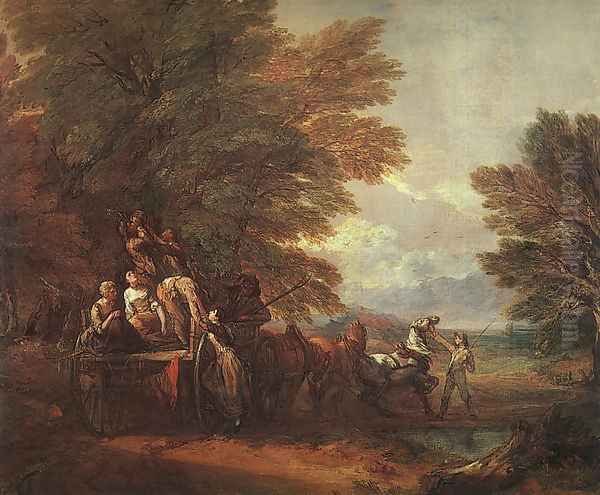
In 1787, while attending the lengthy trial of Warren Hastings, Gainsborough felt a sudden coldness on the back of his neck. This proved to be the first symptom of cancer, specifically a sarcoma that had attached itself to his vertebrae. Despite medical attention, his condition deteriorated rapidly. Knowing his end was near, he reportedly sought a reconciliation with his long-time rival, Sir Joshua Reynolds. Reynolds visited his bedside, where Gainsborough is famously said to have uttered his last words: "We are all going to Heaven, and Van Dyck is of the company." Thomas Gainsborough died on August 2, 1788, at the age of 61. Following his own wishes, he was buried not in Westminster Abbey or St Paul's Cathedral alongside other national figures, but quietly at St. Anne's Church, Kew, near his beloved Richmond riverside scenery.
Gainsborough's death was widely mourned. Even Reynolds, in his subsequent Discourse to the Royal Academy students, paid generous tribute to his rival's natural genius, praising his intuitive understanding of colour, light, and character, even while gently critiquing his lack of academic rigor.
Gainsborough's influence on subsequent generations of British artists, particularly landscape painters, was profound. John Constable revered him, seeing in Gainsborough's work an authentic engagement with the English countryside and a mastery of atmospheric effects. Constable famously declared that "on looking at them, we find tears in our eyes and know not what brings them." J.M.W. Turner also absorbed lessons from Gainsborough's handling of light and colour. Gainsborough's emphasis on capturing the fleeting effects of nature and his poetic sensibility helped lay the groundwork for the Romantic movement in British art. Artists of the Norwich School, such as John Crome, also looked to Gainsborough's naturalism.
Today, Gainsborough is recognized as one of the indispensable figures of British art history. His portraits offer captivating glimpses into the society of Georgian England, while his landscapes celebrate the beauty of the British countryside with unparalleled sensitivity and lyricism. His technical brilliance, combined with his emotional depth and innovative spirit, ensures his enduring importance and appeal. His works are held in major museums and collections worldwide, continuing to enchant viewers with their elegance, vitality, and profound connection to the natural world.
Conclusion: A Dual Master of British Art
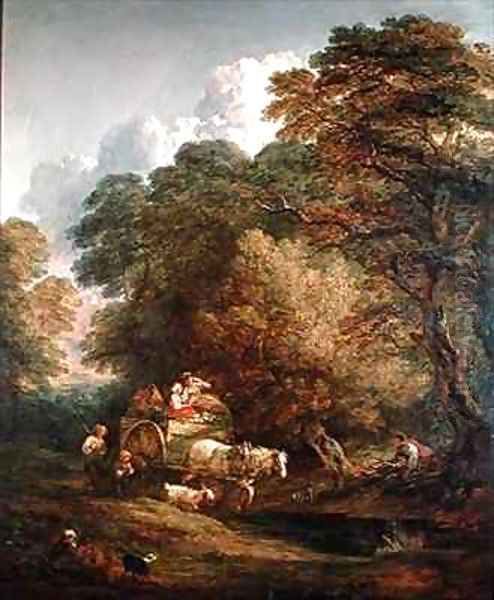
Thomas Gainsborough's contribution to British art is immense and multifaceted. He excelled in the two dominant genres of his time, portraiture and landscape, bringing a unique sensibility and technical brilliance to both. As a portraitist, he rivaled Reynolds, offering an alternative vision based on intuitive grace, psychological acuity, and a fluid, shimmering technique that captured the essence of the Georgian elite. As a landscapist, he followed his heart, creating poetic visions of the English countryside that transcended mere topography and profoundly influenced the future direction of the genre, anticipating the concerns of Romanticism. His independence, his experimental spirit, and his deep connection to both people and nature define his artistic identity. Gainsborough remains not just a key figure of the 18th century, but a timeless master whose works continue to speak with freshness and emotional resonance.